Navigation
Install the app
How to install the app on iOS
Follow along with the video below to see how to install our site as a web app on your home screen.

Note: This feature currently requires accessing the site using the built-in Safari browser.
More options
You are using an out of date browser. It may not display this or other websites correctly.
You should upgrade or use an alternative browser.
You should upgrade or use an alternative browser.
My first darkroom prints
- Thread starter JoL
- Start date
timor
Been spending a lot of time on here!
- Joined
- Feb 28, 2011
- Messages
- 5,905
- Reaction score
- 890
- Location
- Toronto ON
- Can others edit my Photos
- Photos NOT OK to edit
strong click sounds good, lid is not too loose.
timor
Been spending a lot of time on here!
- Joined
- Feb 28, 2011
- Messages
- 5,905
- Reaction score
- 890
- Location
- Toronto ON
- Can others edit my Photos
- Photos NOT OK to edit
I just developed piece of film shot yesterday with camera (old but solid Argus CR2, made by Cosina) which never ever had a light leaks. And guess what, 5 last frames out of 12 have nice light streaks. What I think happened is as I was shooting for about 1 hour in very low temperature, -8C, with wind about -15C, when camera was still warm, no leaks. But later, when equipment cooled down to temperature of surroundings, seals contracted and let go. I was shooting in "open" sun (320 ft-cd). Seals are old, still original, so, maybe is a time to change them. 
JoL
No longer a newbie, moving up!
- Joined
- Mar 18, 2013
- Messages
- 147
- Reaction score
- 82
- Location
- Boston
- Can others edit my Photos
- Photos OK to edit
Oh wow, that's interesting. Maybe I should tape the camera all the time just in case 
Alright, news on my side:
I taped the camera, did a couple of test shots and developed them in very dark darkness...
And below is a picture of the negative in the enlarger. Now even I can see the light streaks.
The question is where they come from? This is puzzling since I taped the camera. Does anybody have a good guess?
Must have happened in the camera since they are so well aligned with side holes, or am I mistaken?
Maybe I didn't tape it well? I guess I neglected the hinge area a little bit, so this might be the reason?
One silly question (film camera noob). Are the light seals usually nice and fluffy?
I'm looking at the big seal close to the hinge and it looks more like an adhesive residue in my opinion. Maybe someone removed the old ones but never put in new ones?
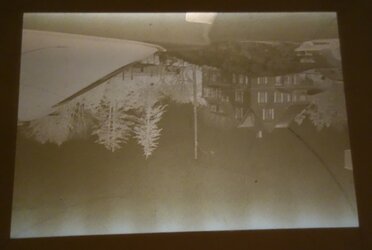
Edit:
The condition of the light seals
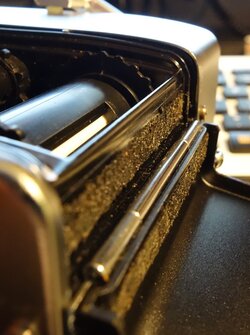
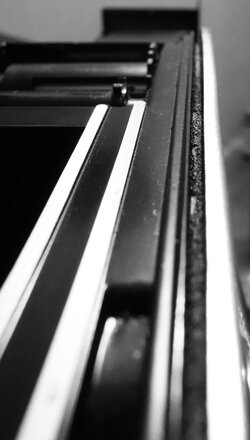
I couldn't resist making the second one black and white. It just looks much better.
The seals seem to be in a crappy condition.
Alright, news on my side:
I taped the camera, did a couple of test shots and developed them in very dark darkness...
And below is a picture of the negative in the enlarger. Now even I can see the light streaks.
The question is where they come from? This is puzzling since I taped the camera. Does anybody have a good guess?
Must have happened in the camera since they are so well aligned with side holes, or am I mistaken?
Maybe I didn't tape it well? I guess I neglected the hinge area a little bit, so this might be the reason?
One silly question (film camera noob). Are the light seals usually nice and fluffy?
I'm looking at the big seal close to the hinge and it looks more like an adhesive residue in my opinion. Maybe someone removed the old ones but never put in new ones?

Edit:
The condition of the light seals


I couldn't resist making the second one black and white. It just looks much better.
The seals seem to be in a crappy condition.
Last edited:
timor
Been spending a lot of time on here!
- Joined
- Feb 28, 2011
- Messages
- 5,905
- Reaction score
- 890
- Location
- Toronto ON
- Can others edit my Photos
- Photos NOT OK to edit
On the hinges side its possible, but not like that. If this is a light leak it is at the bottom side of camera. Now question, in the tank, this streaks were on the top side of the reel or bottom side ?
Edit.
Now I see the seals. Hinge side looks not bad, but the other looks like gonner. Seals should be unbroken and "fluffy" so they squeeze under pressure.
How many frames has this streaks ? What was your agitation ? It looks like bromide drag.
Edit.
Now I see the seals. Hinge side looks not bad, but the other looks like gonner. Seals should be unbroken and "fluffy" so they squeeze under pressure.
How many frames has this streaks ? What was your agitation ? It looks like bromide drag.
Last edited:
timor
Been spending a lot of time on here!
- Joined
- Feb 28, 2011
- Messages
- 5,905
- Reaction score
- 890
- Location
- Toronto ON
- Can others edit my Photos
- Photos NOT OK to edit
During the development salts of bromide are formed and slowly flow downwards inhibiting by covering the emulsion the development. Light leaks on the negative are dark as it is over exposed material. Bromide drag is lighter cause it is not developed silver halides, removed during fixing.
We have to question your agitation, developer and water you are using.
Oh, alignment like this is typical for the drag.
We have to question your agitation, developer and water you are using.
Oh, alignment like this is typical for the drag.
JoL
No longer a newbie, moving up!
- Joined
- Mar 18, 2013
- Messages
- 147
- Reaction score
- 82
- Location
- Boston
- Can others edit my Photos
- Photos OK to edit
Thank you for all the information.
Here my agitation details>
30sec initial swirling, then 10s inverting the tank every minute.
Does anyone have experience with swirling vs inverting with these tanks?
Would swirling without inverting prevent these streaks from occurring?
I could try mixing some new chemicals with RO water and see if it makes a difference, since you mentioned it.
Here my agitation details>
30sec initial swirling, then 10s inverting the tank every minute.
Does anyone have experience with swirling vs inverting with these tanks?
Would swirling without inverting prevent these streaks from occurring?
I could try mixing some new chemicals with RO water and see if it makes a difference, since you mentioned it.
timor
Been spending a lot of time on here!
- Joined
- Feb 28, 2011
- Messages
- 5,905
- Reaction score
- 890
- Location
- Toronto ON
- Can others edit my Photos
- Photos NOT OK to edit
I am afrai problem is deeper. I do mostly swirling with one half inversion at the half time. After that my typical development has a stand phase for 3-4 min. I don't use a short stop. With you there is no agitation problem. Some developers have more tendency to cause drag, IMO borax based (so with metol or phenidone). D76, ID11, ID68 etc. HC110, Rodinal much less. Then high speed films are more vulnerable to drag. Then comes the state of emulsion; older, or more depleted, on the verge of fogging etc. have drag easier. It is not any scientific statement, just years of my own failures and observations.
I suspect your film and developer, maybe developer in conjunction with your local tap water. Try distilled water next time. Try different film.
How many frames has this streaks ? At the end or beginning ?
You may also try a constant agitation with shorter 10-15% time. Just to see how this will work.
I suspect your film and developer, maybe developer in conjunction with your local tap water. Try distilled water next time. Try different film.
How many frames has this streaks ? At the end or beginning ?
You may also try a constant agitation with shorter 10-15% time. Just to see how this will work.
Last edited:
JoL
No longer a newbie, moving up!
- Joined
- Mar 18, 2013
- Messages
- 147
- Reaction score
- 82
- Location
- Boston
- Can others edit my Photos
- Photos OK to edit
I'll try the distilled water. Can you specify more what you mean by constant agitation with shorter 10-15% time?
Take 10-15% off the 6min developing time and constantly swirl the reel? Wouldn't that prevent the developer from reacting properly with the film?
Take 10-15% off the 6min developing time and constantly swirl the reel? Wouldn't that prevent the developer from reacting properly with the film?
timor
Been spending a lot of time on here!
- Joined
- Feb 28, 2011
- Messages
- 5,905
- Reaction score
- 890
- Location
- Toronto ON
- Can others edit my Photos
- Photos NOT OK to edit
Yup. Take off 40 sec. and constantly. slowly swirl the reel and every minute inversion as usual. It will not interfere with development.Take 10-15% off the 6min developing time and constantly swirl the reel? Wouldn't that prevent the developer from reacting properly with the film?
timor
Been spending a lot of time on here!
- Joined
- Feb 28, 2011
- Messages
- 5,905
- Reaction score
- 890
- Location
- Toronto ON
- Can others edit my Photos
- Photos NOT OK to edit
Good luck.
Gavjenks
TPF Noob!
- Joined
- May 9, 2013
- Messages
- 2,976
- Reaction score
- 588
- Location
- Iowa City, IA
- Can others edit my Photos
- Photos OK to edit
That's bizarre, man. I feel for you. Manage to (seemingly) fix one problem and then a completely different one shows up that probably shouldn't be happening at all based on what you describe as a fairly aggressive sounding agitation process...
Some people just don't get any luck.
Some people just don't get any luck.
JoL
No longer a newbie, moving up!
- Joined
- Mar 18, 2013
- Messages
- 147
- Reaction score
- 82
- Location
- Boston
- Can others edit my Photos
- Photos OK to edit
Good point, Gavjenks. I totally forgot about the original problem I had with the football sized grain or whatever it was. I do not know if it was fixed by focusing on a dark environment, but since this new and more pronounced problem showed up I decided to try to fix that first and then see if that already has an impact on the grain problem.
Maybe the bromide salt streak problem due to the development process only got easily detectable now because I fixed the first problem with the light? Who knows... I might replace the light seals on the camera either way, just in case.
And maybe I'll switch to loading only half a film strip into the reel for my developing tests... Otherwise I'll burn through too many rolls.
I actually prefer this whole error elimination process instead of getting everything right the first time by following a standard instruction. This way I am learning so much more about the film developing process.
Maybe the bromide salt streak problem due to the development process only got easily detectable now because I fixed the first problem with the light? Who knows... I might replace the light seals on the camera either way, just in case.
And maybe I'll switch to loading only half a film strip into the reel for my developing tests... Otherwise I'll burn through too many rolls.
I actually prefer this whole error elimination process instead of getting everything right the first time by following a standard instruction. This way I am learning so much more about the film developing process.
Similar threads
- Replies
- 0
- Views
- 846
- Replies
- 7
- Views
- 1K
- Replies
- 10
- Views
- 953

![[No title]](/data/xfmg/thumbnail/41/41797-ed370d68dae70f5b0a7252ec2d525912.jpg?1619739896)
![[No title]](/data/xfmg/thumbnail/40/40288-4d5d7a8aa74ddfceb5fb82062d9b21be.jpg?1619739409)
![[No title]](/data/xfmg/thumbnail/36/36654-55e621bd8f3203cdd106e3764c553c4d.jpg?1619737673)



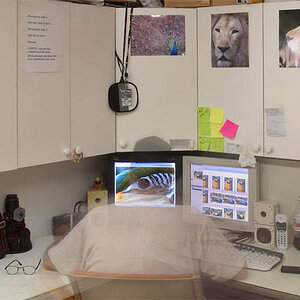
![[No title]](/data/xfmg/thumbnail/33/33031-909b1e1ff8739eef165c60b70c9a6a38.jpg?1619735845)
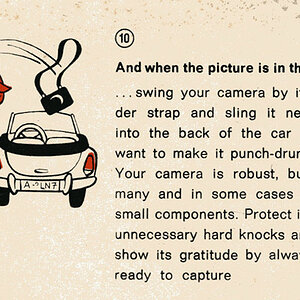

![[No title]](/data/xfmg/thumbnail/40/40284-f59f6230f0d5b9eacf977f8b0392f087.jpg?1619739407)
